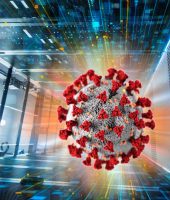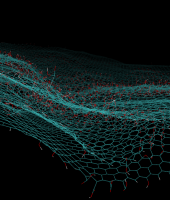Turning toxins into treatments
Summary
One in five Australians lives with chronic pain, a debilitating disorder which also afflicts adolescents and children, and this rises to one in three people over the age of 65. When physical pain is routinely felt in the absence of an external stimulus, it becomes a problem of our central nervous system.
Researchers have turned to toxins produced by venomous animals to find an alternative treatment for chronic pain and other neurological disorders. Dr Andrew Hung from the College of Science, Engineering and Health at RMIT University is using Pawsey Supercomputing Centre to discover exactly how the chemicals known as conotoxins interact with our nervous system, guiding drug design to turn these toxins into a stable new pain relief drug.
The Challenge
Toxic substances found in marine cone snails, known as conotoxins, contain small proteins (peptides) that interact very strongly with our nervous systems. This makes them promising starting materials for drug development to treat neurological disorders, including chronic pain. As Dr Hung explains: “conotoxins attach strongly to a range of different receptors in the nervous system, but we need to modify them so that they attach only to very specific targets. If we can ‘tune’ their binding to be selective to only a particular receptor, we can control their action to achieve the effect we want from a drug – pain relief – without other side effects”.
Thousands of natural conotoxins are known, and more can be created through chemical modification, so the potential to tune their selectivity and activity is high. This fine-tuning requires an understanding of exactly how the toxins interact with our nervous system, the ‘molecular handshake’ that occurs between the peptide and various receptors in the nervous system. Subtly altering the shape and chemical properties of the peptide can then affect how strongly and selectively they attach to a specific receptor.
Other modifications also need to be made to improve peptide stability in the human body, as this defines how they can be used. Peptide-derived drugs, such as insulin, are usually broken down and digested if swallowed, so they are often only injectable directly into the bloodstream. Making changes to improve peptide stability with respect to digestion raises the possibility of creating an ingestible painkiller, but any changes made can potentially also affect the strength and specificity of the drug binding.
The Solution
Dr Hung is using molecular modelling and simulation methods to identify the specific binding interactions that define the molecular handshake between conotoxins and their known receptor targets. “We build an atomic model of the toxin and of the receptor in the cell membrane and add all of the water molecules and ions that would be there as well. Fortunately, the structures of the toxins and receptors are already quite well known, so that gives us a good starting point to explore how they behave. We then run molecular dynamics simulations to see how they all move and interact, which parts of the structures contact most closely, and how strong that binding is.”
A typical model contains about 300,000 atoms, and atomic movements are tracked for hundreds of nanoseconds, so supercomputing facilities are essential to manage the number of computations involved. Dr Hung explains: “There’s a trade–off between how big a system you can model and how long you can run it for, to reasonably see all of the interactions that are likely to happen in nature. And we have to run each system from several slightly different starting positions to make sure we capture all the likely interactions. This then gives us the range of movements that occur in the molecular handshake, the specific points of contact that are important, and how the toxin affects the receptor”.
Outcome
By understanding the binding mechanism through simulation, Dr Hung can then modify the structure of the peptide models to investigate which modifications lead to more selective or stronger binding.
These results are shared with researchers at the Illawarra Health and Medical Research Institute, led by Professor David Adams. His team creates and tests promising toxin variants in real biological systems to measure the strength and selectivity of their action. Their real-life results then confirm the most promising variations to explore further in the next round of molecular modelling.
“It’s an iterative approach to develop a new peptide-based drug,” says Dr Hung. “Understanding these structure–activity relationships is letting us create novel peptides with characteristics more and more suitable for therapeutic testing. A stable oral analgesic for chronic pain is the goal.”
Project Leader.

Conotoxins (red ribbon) bind to specific sites on their target neuronal protein receptors (blue & yellow ribbons), inhibiting their function as signal transmitters in the nervous system. Image courtesty, Dr Andrew Hung, RMIT University

Molecular simulations can act as 'virtual microscopes', allowing us to visualise specific interactions between toxins and neuronal proteins- down to the individual atoms. Images courtesty, Dr Andrew Hung, RMIT University





